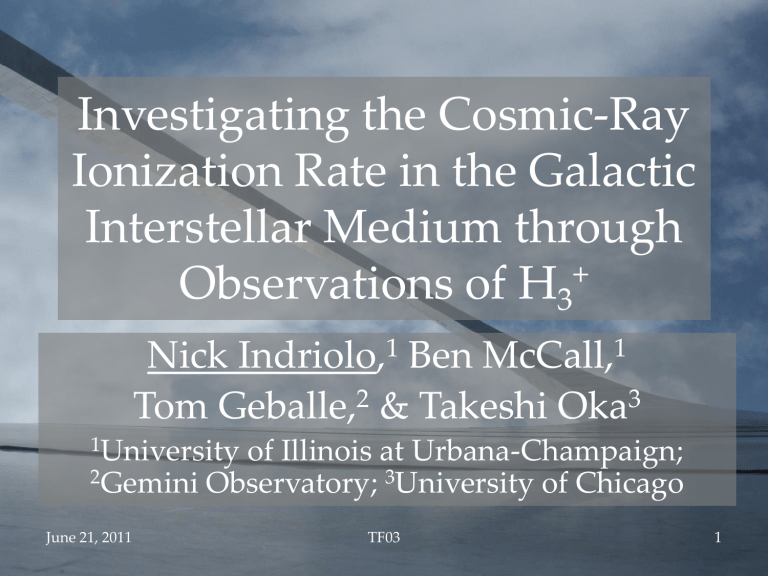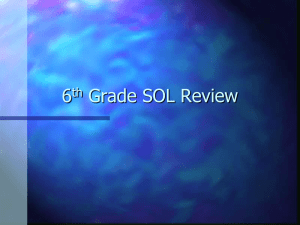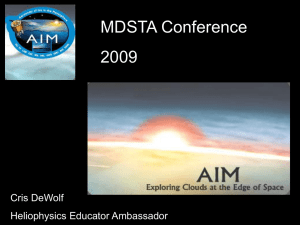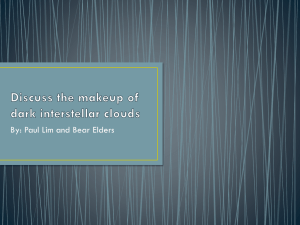University of Illinois at Urbana

Investigating the Cosmic-Ray
Ionization Rate in the Galactic
Interstellar Medium through
Observations of H
3
+
Nick Indriolo, 1 Ben McCall, 1
Tom Geballe, 2 & Takeshi Oka 3
1 University of Illinois at Urbana-Champaign;
2 Gemini Observatory; 3 University of Chicago
June 21, 2011 TF03 1
Introduction
• Gas phase chemistry (ion-molecule) proposed in forming smaller molecules
(Watson 1973; Herbst & Klemperer 1973)
• Requires a source of ionization
• Cosmic rays ionize H, He, and H
2 throughout diffuse molecular clouds, forming H + , He + , and H
3
+
• Initiates the fast ion-molecule reactions that drive chemistry in the ISM
June 21, 2011 TF03 2
Ion-Molecule Reactions
H
CR
H
2
CR
H +
O
H
2
+
O +
H
2
H
2
N
2
H +
H
3
N
2
+
CO
O
OH +
H
2
HCO +
H
2
O +
H
2
H
3
O +
• Low proton affinity of H
2 makes H
3
+ especially willing to transfer its charge
June 21, 2011 TF03 3
ζ Over the Past 50 Years
Hayakawa et al. 1961; Spitzer & Tomasko 1968; O’Donnell & Watson 1974; Hartquist et al. 1978; van
Dishoeck & Black 1986; Federman et al. 1996; Webber 1998; McCall et al. 2003; Indriolo et al. 2007;
Gerin et al. 2010; Neufeld et al. 2010
June 21, 2011 TF03 4
H
3
+ Chemistry
• Formation
– CR + H
– H
2
+
2
+ H
2
H
H
2
+
3
+
+ e + CR’
+ H
• Destruction
– H
3
+
– H
3
+
– H
3
+
– H
3
+
+ e -
H + H + H (diffuse clouds)
+ O
OH + + H
2
(diffuse & dense clouds)
+ CO
HCO + + H
2
(dense clouds)
+ N
2
HN
2
+ + H
2
(dense clouds)
June 21, 2011 TF03 5
Steady State Equation
June 21, 2011 TF03 6
More Complete Steady State
• Proton transfer to O and CO also destroys H
3
+
• During formation process, H
2
+ can be destroyed prior to reaction with H
2
– H
2
+
– H
2
+
+ H
H
2
+ H
+ e -
H + H
+
June 21, 2011 TF03 7
Validity of Approximation
June 21, 2011 TF03 8
Necessary Parameters
• k
• x e e measured approximated by x(C + )≈1.5
10 -4
• n
H estimated from C analysis, or H & H
2
2 analysis, C I
(J=4) analysis
• N(H
2
) from observations, estimated from
E(B-V), or estimated from N(CH)
June 21, 2011 TF03 9
Targeted Transitions
Energy level diagram for the ground vibrational state of H
3
+
• Transitions of the
2 band of H
3
+ the infrared
0 are available in
• Given average diffuse cloud temperatures (70 K) only the
(J,K)=(1,0) & (1,1) levels are significantly populated
• Observable transitions are:
– R(1,1) u : 3.668083 μm
– R(1,0): 3.668516 μm
– R(1,1) l : 3.715479 μm
– Q(1,1): 3.928625 μm
– Q(1,0): 3.953000 μm
June 21, 2011 TF03 10
Survey Status
Dame et al. 2001
• Observations targeting H
3
+ in diffuse clouds have been made in 50 sight lines
• H
3
+ is detected in 21 of those
June 21, 2011 TF03 11
Example Spectra
June 21, 2011 TF03 12
Inferred Ionization Rates
June 21, 2011 mean ionization rate: ζ
2
=3.3±0.4
10 -16 s -1
TF03 13
ζ
2 versus Galactic Longitude
June 21, 2011 TF03 14
ζ
2 versus Total Column Density
Dense cloud results from Kulesa 2002 and van der Tak & van Dishoeck 2000
June 21, 2011 TF03 15
Particle Range
Range for a 1 MeV proton is ~3
10 20 cm -2
Range for a 10 MeV proton is ~2
10 22 cm -2
Diffuse cloud column densities are about
10 21 ≤ N
H
≤ 10 22 cm -2
June 21, 2011
Padovani et al. 2009
TF03 16
Implications
• Likely that cosmic rays in the 2-10 MeV range operate throughout diffuse clouds
• Only higher energy particles (E>10 MeV) contribute to ionization in dense clouds
• Variations in ζ
2 amongst diffuse clouds due to proximity to acceleration sites
• Particle spectrum is not uniform in the
Galactic ISM
June 21, 2011 TF03 17
Reproducing High Inferred ζ
2
June 21, 2011
Using both components: ζ
2
=3.7
10 -16 s -1
Using only base component: ζ
2
=0.14
10 -16 s -1
TF03 18
SNR versus Diffuse ISM
• Ionization rates near IC 443
– ζ
2
~20±10
10 -16 s -1
• Ionization rates in the diffuse ISM
– mean: ζ
2
– max: ζ
2
– min: ζ
2
=3.3±0.4
10 -16 s -1
=10.6±6.8
10
<0.4
10 -16 s -1
-16 s -1
• Consistent with theory that ionization rates are higher near acceleration sites
June 21, 2011 TF03 19
Conclusions
• Variations in ζ
2 amongst diffuse clouds are due to differences in the cosmic-ray spectrum at MeV energies which result from particle propagation effects and proximity to acceleration sites
• Supernova remnants accelerate MeV particles, but it is unclear if these can cause high ionization rates throughout the
Galactic ISM
June 21, 2011 TF03 20
Acknowledgments
• Brian Fields
• Geoff Blake
• Miwa Goto
• Tomonori Usuda
June 21, 2011 TF03 21








